Description
Desert Spirits, Grasslands Hunters, Jungle Horrors!
The Southlands Bestiary brings 90+ new monsters of the hotter climes to Pathfinder Roleplaying Game. Want to run a campaign in the deserts, jungles or savannas? This 120-page tome of monsters will make sure your players will have hair-raising encounters like none they’ve experienced before.
With this full-color book of monsters you get:
- Swamp adders, sphinxes, scorpion swarms and skinbats!
- Demons, devils, dinosaurs and dragons!
- Possessed pillars and prismatic beetles!
- Genies, gremlins and golems!
- Killer cactids and clockwork tomb guardians!
…and so much more, plus an introduction by Jeff Grubb, designer of the classic Al-Qadim setting. Use these strange and deadly foes in the Midgard Campaign Setting, or in any campaign of high adventure beneath the pitiless sun.
Draw your scimitar, ready your spear, and call upon whatever gods you choose, mortals: the monsters of the Southlands are here!


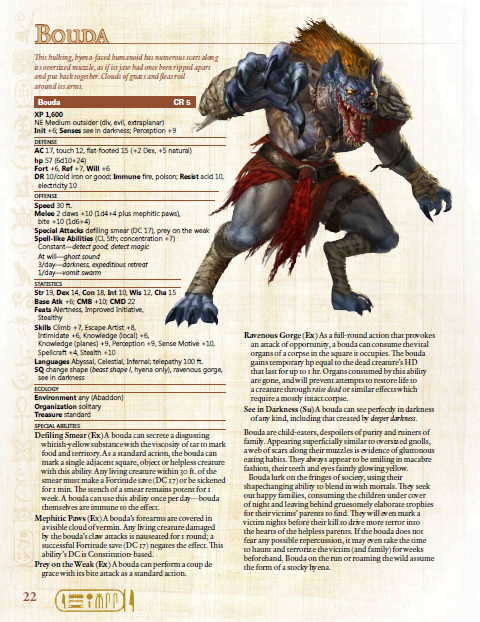
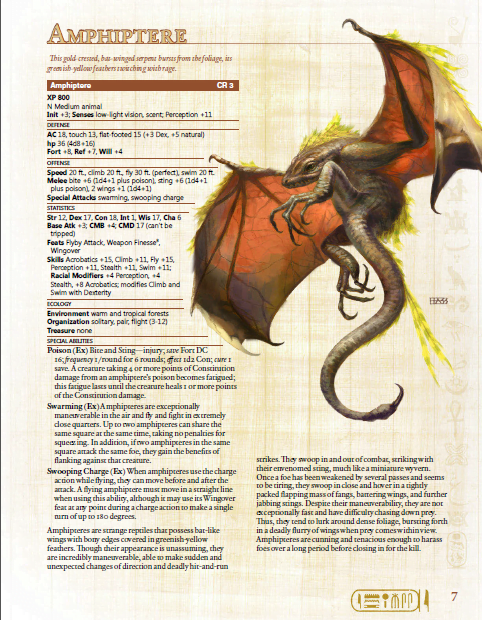
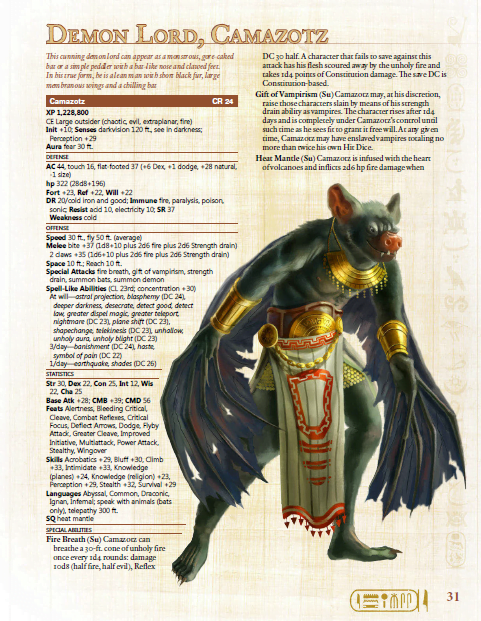
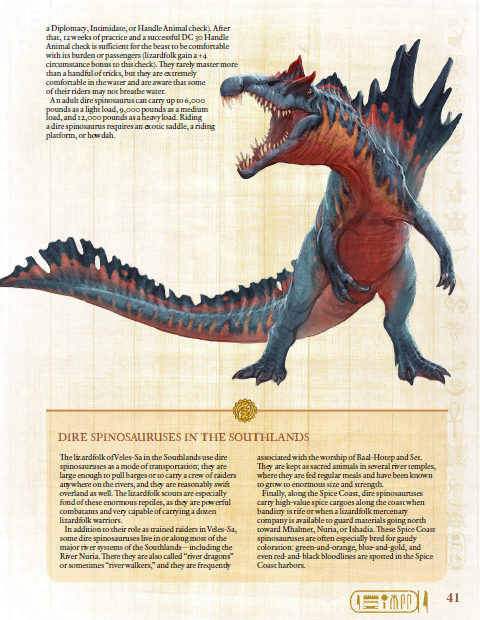
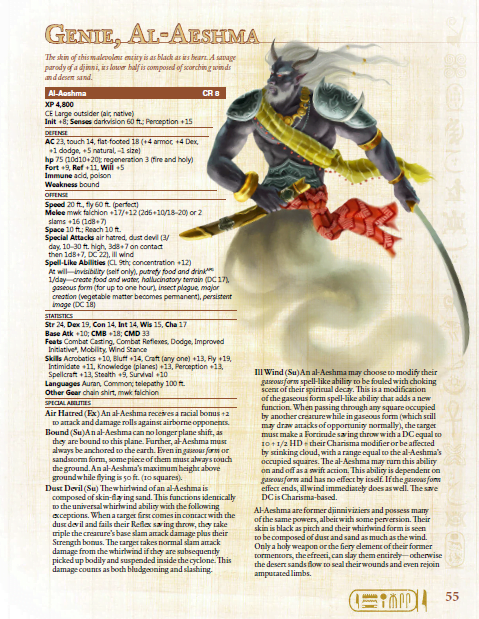
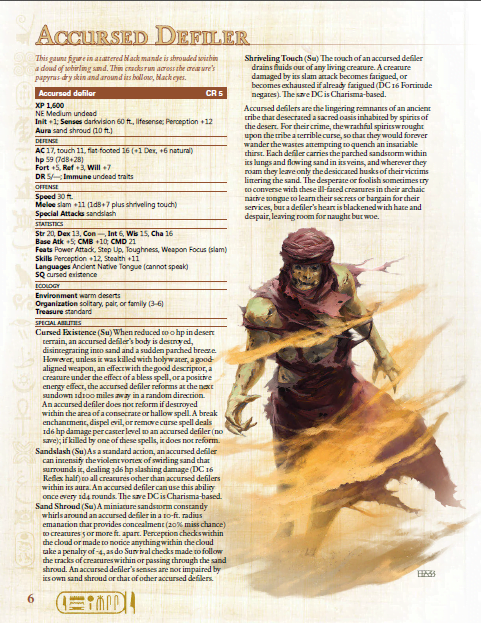
Megan Robertson –
Early explorers of distant and far-off lands often define them by the creatures to be found there, so here is a collection of diverse and fascinating beasts to populate the Southlands and terrorise incautious visitors. These creatures are at home, the party are the interlopers, having to deal with the rigors of the setting as well as the actual monsters themselves. A new land with new monsters provides a challenge to players as well as to their characters as both are venturing someplace new. It’s also a way to get over the obstacle of a character knowing more about his surroundings (including the monsters) than his player does!
There’s a wealth of opportunity for the GM as well. Treat the monsters not as mere cannon-fodder but as a living, breathing part of the world that they inhabit. The ultimate challenge for the characters may well be to engage in combat with the monsters, but what of learning about them first? Observations can be made, legends learned, and so on, enabling the characters to know something about these new creatures before having to fight them… or such observations can be made after the first stunning shock of a combat encounter as the characters regroup, figure out what attacked them and how they can detect and deal with it in the future.
Even if you don’t want to use the Southlands in your game, or the plot does not call for the party to go there right now, the odd creature might have strayed elsewhere. You may have a suitable ecological niche for it where your game is currently set, or it may have strayed – perhaps as an exhibit in a menagerie – far from its natural habitat. There’s always scope for new monsters….
The Introduction touches on these concepts and then we’re off with an array of monsters presented in alphabetic order. Each comes with all the details we have come to expect: a description, complete stat block, notes on lifestyle, habitat and behaviour and a glorious full-colour illustration. Most entries fill a single page, else they fill two, so users of the PDF will be able to print out the pages that they need without extraneous material. There’s almost an hundred of them to feast your eyes upon and build adventures around; and there’s a table listing them by CR at the back to help you in setting up encounters appropriate to your characters.
Many of the monsters are uniquely suited to the Southlands, both ecologically and in terms of the overall style of the campaign setting. Perhaps a gentle stroll across the desert will be interrupted as two speckled, wickedly pointed legs erupt from the sand, plunging forward with murderous speed, followed by a spider the size of a rhino… the evocative description provided for the sand spider. Another beast, the subek, is a humanoid crocodile which retains many of the fighting techniques of the animal that is its inspiration such as the ‘death roll’ of a crocodile dragging its prey underwater to drown, adapting the technique to a land-based grappling manoeuvere.
The giant white apes reflect legends about super-intelligent gorillas found in the depths of Congo rain forests, twisted to suit the Southlands setting yet evoking the same awe and curiousity. The monsters range from pure animal to sentient, from desert dwellers to jungle inhabitants – whatever your needs there is likely something that will suit. Beautifully presented and well-considered, if you are using the Southlands Campaign Setting or have another area occupying the ecological niche of Africa in your world, these creatures will help to bring it to life.
Endzeitgeist –
An Endzeitgeist.com review
This massive bestiary for use with the Southlands campaign setting (but not limited to it) clocks in at 122 pages, 1 page front cover, 1 page editorial, 2 pages of backer-lists, 1 page ToC, 1 page SRD, 2 3/4 pages of advertisement, 1 page back cover, leaving us with 112 1/4 pages of content, so let’s take a look!
I was a backer of the Southlands kickstarter, but am otherwise not involved with this book. My review is primarily based on the softcover print version of this book, though I consulted the electronic version to verify e.g. presence of bookmarks and similar components.
This book is pretty much a sans frills experience – the brief version of this review would be as follows: After an introduction by Jeff Grubb, we dive into a ton of monsters; in the end, there is a table of monsters by CR; they span the breadth from humble CR 1/2 to massive CR 26.
…
Yeah, I know, not very fulfilling now, is it? Let’s try to do this more justice: We have, at this point, seen more than one book (or chapter) on creatures of the deserts – there usually are a couple of undead, some ambush predators, a killer scarab, the like. We know the tropes and this book very much is aware of this – instead of simply resorting to trying to re-invent the wheel, it pretty much says: “So yeah, you do – but guess what? You haven’t seen THIS done!” What do I mean by this? Well, for one, the massive book has something unique going on for every creature – there is no boring rehash of old tricks in this book. That tentacley ambush-predator cactus you’ve seen done before? Well, it can generate a lethal aura of spikes by shooting them all at once in a pinch. That undead, doomed to wander the desert? Let’s just say that it can be used in Ravenloft sans modification, since it requires brains to defeat it.
The second component that sets this apart is that, much like the Southlands-book, it borrows heavily on real world mythology and adds a unique spin to it – Mechuitl and Camazotz, for example, are statted as full-blown demon lords – including e.g. information on Camazotz in the underworld… Similarly, monster tropes are combined with great panache with Midgard flavor – Clockwork Shabti and Ushabti, for example tie in perfectly with the gearforged concept, while the types of tosculi and their master, dread Arbeyach, prince of swarms also get their due.
Speaking of resonance with real world myth – if you’re familiar with Prester John’s myth, you’ll be like me and grin from ear to ear upon seeing the Blemmyes statted. The lightning-infused swarm “Bolt of Ekwanes” similarly resounds with a deep pulse of the familiar and yet unique. Fans of ancient mythologies will also cheer at the rendition of noble Buraqs, while drought swallows threaten the land and well-being of those foolish enough to attract their attention. Salt-devils scour the lands and demonic idolic deities await to be unearthed, while owl-headed harpies prey on the travelers.
Intelligent ambush predator spiders called J’ba Fobi or the smoke-lions mngwas, carnivorousnandi bears or an ooze camouflaging as whole oasis – the breadth and depth of adversaries and creatures covered herein is wide indeed. Perhaps you want a pygmy trumpeteer elephant companion? Heck, even the tired old desert worm gets a new twist, with Sathaq worms sporting a pain-inducing aura and a hunting style based on dragging foes beneath the sands. Even the classic hybrids that in earlier days sometimes ended up being less than interesting have great representations herein – the lethal serpopard (serpent-leopard-hybrid) is a brutal foe, while an orangutan-choker hybrid should, by all accounts, end up on a ridiculous monster-list…but it does work! Insectoid Xhkarsh can afflict their victims with oracle curses and creatures mentioned in the great setting book, from the twisted vine lords to the arcane wasting-bearing intelligent white apes resound with themes of our collective cultural consciousness.
The mythic Southlands titans do sport notes on words of power (and an optional, non WoP-array of SPs) while the wakane, a feathered pterosaur, is particularly feared for sinking boats – have I mentioned the huge, burrowing pitcher plants masquerading as an oasis, commanding whole swarms of its rootlets to defeat resilient prey? There is a lot of downright inspired material to be found herein and not one of the creatures in this book felt lazy or bland.
Conclusion:
Editing and formatting are top-notch – while e.g. MR is not capitalized in a statblock and while I noticed some small hiccups, overall, the book is solid. The statblocks I checked sported no glaring glitches. Layout adheres to a gorgeous two-column full-color standard and the pdf is fully bookmarked. The book has a huge selling point: The artwork is absolutely fantastic. original and truly evocative, full-color artworks for all creatures are provided and they are downright baffling, eclipsing even most 1st party bestiaries. Some of the artworks are so beautiful, they make you immediately want to use the creature they represent – and this holds true for just about all of them. Look at the cover: This is the level of awesomeness you get throughout the whole book.
Here’s the awesome thing, though: As a long-time supporter of Kobold Press, I have, time and again, bemoaned the fact that some of the truly astounding full color pdfs were translated “only” into b/w-print copies. Not so here: The Southlands Bestiary’s print version is a truly gorgeous full color softcover that features thick, glossy paper and thus is a joy to simply flip open – if you can, get the print edition.
Okay, so here is the list of designers:
Kristian Ahonen, Eric Anderson, Anonymous, Joshua Banks, Wolfgang Baur, dpb, Clinton Boomer, Marina de Santiago Buey, Angelica Burns, Jarrod Camiré, Aaron Cheung, Jim Davis, Lee DeBoer, Dan Dillon, John Doh, Chris Doyle, Harold Farmer, John Foster, Erik Freund, Leonard Grand, Amanda Hamon Kunz, Andrew Harshman, Jacob Haywood, Steven T. Helt, Jeffrey Hersh, Andrew Hind, Richard Iversen, Alex Kanous, Henry S. Kurtz, Richard Lawson, Jeff Lee, Chris Lockey, Ari Marmell, Ben McFarland, Jesse McGatha, Brett A. McLean, Brian Wiborg Mønster, Matt Morrissette, Robert H. Nichols, Stacy Nichols, Kalervo Oikarinen, Gunnar Ólafsson, Richard Rossi, Stephen Rowe, Adam Roy, Wendall Roy, Matt Rupprecht, Allen F. Schell, Brian Suskind, Troy Taylor, James Thomas, John Tolios, James Whittaker, Clarence Wisdom, Henry Wong – in spite of the established names among these ladies and gentlemen, one would expect quality to fluctuate. At least as far as I could tell (or where it would become jarring or problematic for the GM), I could not observe any tendency like that – Ben McFarland, Justin Riddler, Alistair Rigg, Brian Suskind, Jason Nelson and Amanda Hamon Kunz have done a glorious job reviewing, editing and developing these creatures – and the effort show. This is a superb bestiary, perhaps one of the most compelling ones I’ve read all year.
Even if you’re not interested in Midgard or Southlands, I very much recommend you get this gorgeous tome – this is a glorious bestiary and well worth 5 stars + seal of approval as well as nomination as a candidate for my Top Ten of 2015.
Endzeitgeist out.